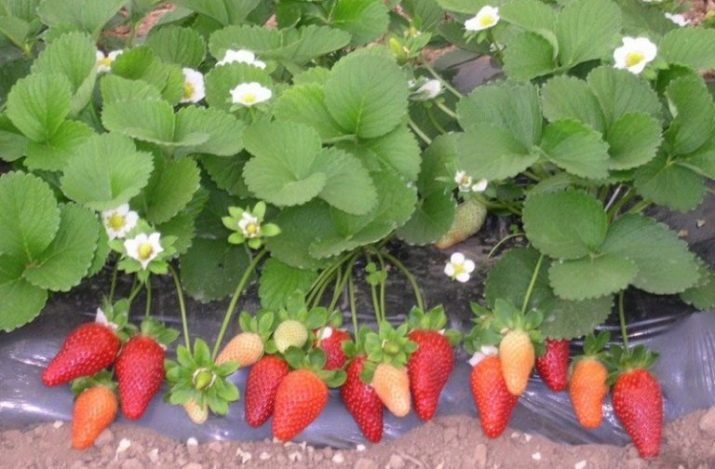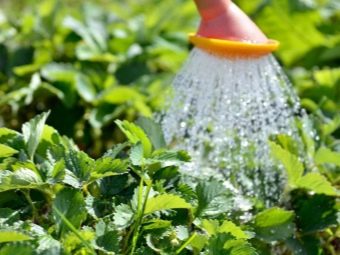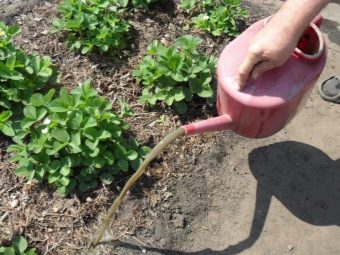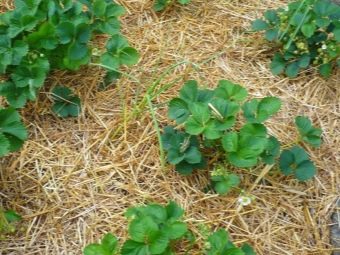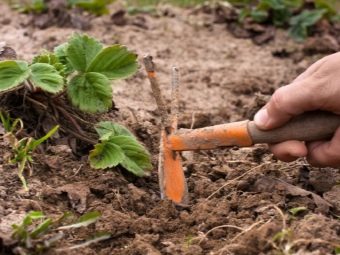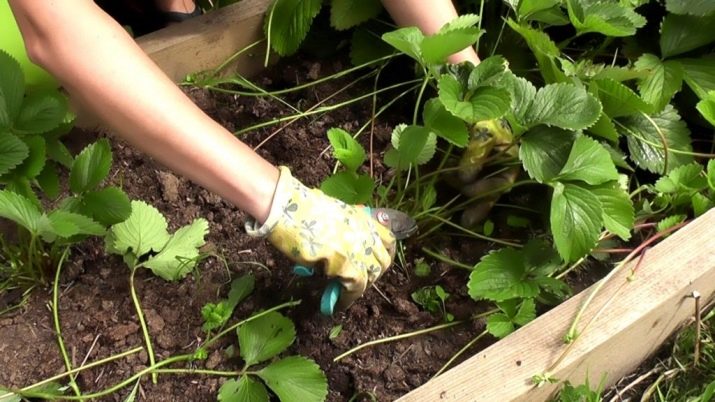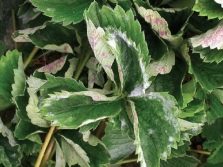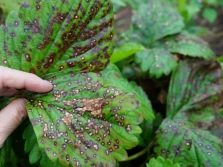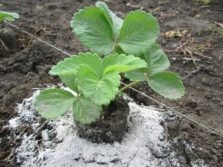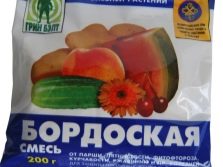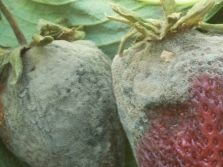Features care for remontany strawberries after the first harvest
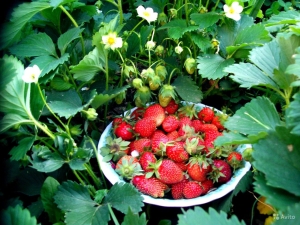
Strawberries, or strawberries, begin to bear fruit in the first half of summer.She can say, opens the berry season. Some varieties are able to produce 2-3 harvests during the summer months. And after the June fruiting, weakened berry bushes need to gain strength for the ripening of new fruits. The article will discuss what care is required for remontant strawberries after the first harvest.
What does the repairman mean?
Strawberry varieties of this type do not differ either in appearance or in any specific characteristics of the berries. The peculiarity of the garden strawberry is that it can produce berries several times per season. If conditions are favorable, and warm weather lasts for a long time, some remontant varieties have time to bear fruit 3-4 times over the summer.
The first crop ripens in June and early July. After that, on the bushes again flower stalks form, and after a while the fruits are tied. The second fruiting is completed in early August.
Sometimes experienced gardeners donate the June harvest, cutting off the primrose on the bushes. After this procedure, the plant does not expend strength on early fruiting. Many of those who use this technique insist that they get an excellent harvest from the second strawberry fruiting as a result.
But what if you want to feast on delicious berries most of the summer? In addition, the fruits of strawberries are used for cooking sweet homemade preparations. In this case, I do not want to lose the first crop at all.
To achieve the optimal "golden mean" is not at all difficult. It is only necessary to ensure proper care of strawberries in the interval between fruit bearing: water, fertilize, weed the beds, if necessary, treat from parasites, carry out disease prevention.
Further, the necessary agrotechnical measures and works that should be carried out after the first harvest of remontant strawberries will be described.
Watering and fertilizer
As mentioned above, the bushes are somewhat depleted after the berries ripen. To help them gain strength for later fruiting, you need to continue to care for them. In particular, it is important to ensure adequate fertilization and watering.
- Garden strawberry responds well to nitrogen-containing fertilizers. But in no case should not be watered with a concentrated solution of urea. It is best of all if this substance will be brought in a complex with other minerals. The optimal ratio of the necessary nutrients is contained, for example, in the complex preparations “Autumn”, “Fasco”.
- Also should not ignore the introduction of organic matter into the soil. It is useful to feed garden strawberries with peat, humus, rotted manure. Bird droppings can be used sparingly, mixed with other organic fertilizers.
- Weakened berry bushes need potassium and phosphorus intake. They can also be applied with irrigation using ready-made complex preparations.
- Regular and sufficient watering of strawberries should continue after the first harvest. But it is important not to overdo it. To avoid overmoistening and stagnant moisture in the soil, it is best to organize drip irrigation. In hot dry weather, water the bushes need at least 1 time in 2-3 days. It is recommended to carry out watering with heated water in small portions under each bush.
- In the piggy bank of folk recipes there are several non-standard compositions for fertilizing berry bushes. One of them is watering nettle extract. The bucket must be filled to a third with the stems and leaves of a freshly cut plant. Bay up to the top with water and covered with a lid, put the nettle in the sun and insist for a week. The resulting liquid (with a not too pleasant smell) is diluted with water in a ratio of 1: 1.
- According to many gardeners, a good nutritional effect is given by feeding with yeast solution.
Priming
Many mulch the soil in the beds with plantings of strawberries. This helps to avoid drying out of the soil, the growth of weeds, and also facilitates the picking of berries.If the soil was covered with a layer of mulch, it is desirable to collect and replace it with a new one. If the strawberry was grown on ordinary, not covered with anything beds, you should take care of the removal of weeds. Root competition takes away from the berry bushes nutrients that are very necessary to her after the first fruiting.
Attention should be paid to the state of the root zone. Quite often after repeated watering, the upper roots of the plants may be slightly exposed. This leads to their drying out and dying off. If under the bush visible bare areas of the roots, you need to lightly sprinkle them on the ground.
Do not stop regular soil loosening. Without this, a crust forms on the surface of the soil in the root zone of the plants. Compacted soil poorly passes micronutrients, moisture and oxygen to the root system. In this case, the efficiency of fertilizing and irrigation is significantly reduced.
The soil on the beds with strawberry plantings should be loose and moderately moist.
Pruning bushes
All varieties of strawberries give a large number of whiskers. Naturally, with their active development, the plant is forced to spend a lot of strength and nutrients. And in the case of the usual types of strawberries, further tactics are very simple: the excess overgrowths and whiskers are cut off. However, remontant strawberries often have time to root tendrils and even give them a crop that is not so abundant, but not too much for a gardener. How to be?
If you watch carefully, you can see that the berries are not tied at all whiskers, but only at the very first. They are always longer than the others. To get an additional amount of fruit for the second harvest should be left only them. Smaller and younger antennae can be safely removed.
In July, a lot of damaged, yellowing or already dried leaves appear on the bushes. They should be cut off. Also, all parts of a plant with signs of disease or pest damage should be removed.
When the flower stalks again form on the plants, you need to pay attention to their number. If the ovaries are too much, the fruits are likely to be crushed and will ripen much longer. Therefore, flowers, if there are a large number of them, should be carefully thinned.
Diseases and pests
Unfortunately, not a single berry culture is 100% immune to diseases and attacks of parasites. Strawberries are no exception. Fighting already progressive diseases and plant-based pests often involves the use of poisonous insecticides. But in the case of remontant strawberries, this is highly undesirable, because the next harvest is on the way.
A major role in this case is played by the prevention and strengthening of the protective forces of the plant.
If, after the first fruiting, berry bushes have obvious signs of illness, it is unlikely to get a good re-harvest. The same goes for the attacks of most voracious parasites. In this case, the most favorable solution would be trimming the crown of bushes. Or reproduction of strawberries with a healthy mustache in a new place.
Repair strawberry rarely bears fruit for more than 2 seasons. In rare cases, under the most favorable conditions, this type of berry crop yields a harvest for three years in a row. Next requires updating the bushes and transplanting. Therefore, the fight against serious diseases and parasites with insecticides is not entirely justified. In case of successful destruction of insects and pathogens, the harvest will still be lost.
For the prevention and protection of strawberry bushes you can apply gentle methods:
- In the root zone, scatter a small amount of ash. It effectively repels some pests and negatively affects fungal microorganisms.
- If snails or slugs were found on a number of growing crops, they can attack strawberries. To avoid this, the leaves should be powdered with cornmeal.
- After removal of the first harvest bushes can be treated with Bordeaux mixture.But this should be done before the second generation of flower stalks.
- Pharmaceutical alcohol solution of iodine, according to the assurances of experienced gardeners, is an excellent and reliable means of prevention. For spraying strawberries, 15 drops of the preparation are added to a bucket of water. Treating bushes is carried out before or during flowering.
- Weak pink solution of potassium permanganate can be applied to the soil with irrigation, as well as used for spraying plantings.
- Gray rot is a very unpleasant fungal disease that causes great damage to the berries. To combat it, as well as to prevent the development of this disease, use mustard powder. About 50 g of the powder is dissolved in 5 liters of hot water, but not boiling water. The mixture should be left for 48 hours, then add another 5 liters of water.
The composition can be used during flowering and fruit ripening. Berries he does not hurt.
About what are the features of care for remontant strawberries after the first harvest, see the next video.

